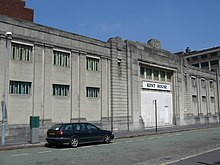Hurley Robinson



Archibald Hurley Robinson FRIBA (14 June 1883[1] – 24 February 1953)[2] was a prolific English architect of cinemas prior to the Second World War.
Biography
[edit]Robinson was born in Handsworth, Staffordshire.[3] After serving in the Royal Air Force in the First World War,[4] he set up his own practice which was initially called Hurley Robinson & Sons and then renamed Hurley Robinson & Partners, which were both based in Birmingham, England.
His work on cinemas was mainly during the 1930s. His cinemas were mainly of the Art Deco style that was popularly used by Oscar Deutsch for his Odeon Cinemas. A lot of Robinson's work was commissioned in the Midlands area of England.
Hurley Robinson remodelled the Salters' Hall in Droitwich Spa, Worcestershire to become a cinema in 1933. This was again altered to become a library in 1982.[5] He also designed the Ritz Cinema in Bordesley Green, Birmingham.[6] A pre-World War II work by Robinson was the Lee Longlands furniture store on Broad Street, Birmingham. This was completed in 1931, and is a rare example of a building that was not a cinema by Robinson before the war. The building was extended in 1939.[7] Another example of a pre-World War II work by Hurley Robinson is the Kent Street Baths in Birmingham which was built between 1931 and 1933. The Art Deco baths survived, unused, until September 2009. His Sparkhill Baths, from the same era, still stand. Hurley Robinson also designed the Dudley Hippodrome theatre, which was built in 1938.[8]
Following World War II, the cinema business deteriorated and Robinson's work was less concentrated on this aspect of construction. In 1959, Robinson was commissioned to design an extension to a factory used by Rootes Motor Parts Limited on the Coventry Road in Birmingham.[9] Also in 1959, construction of Norfolk House on Smallbrook Queensway, Birmingham was completed. The bow-fronted building was originally intended to be a warehouse, however it later incorporated offices and retail units and is now locally listed. The façade is clad in stone and there is a wavy shell concrete canopy above the street level.[10]
Cinemas
[edit]Cinemas designed by Robinson include:
| Name | Location | Constructed/ Opened | Closed | Seats | Screens | Additional notes or references | Coordinates | |
|---|---|---|---|---|---|---|---|---|
| Cannon Bristol Road (also known as ABC Bristol Road) | Edgbaston, Birmingham | 16 May 1937 | 16 May 1987 | 1,712 | 3 | [11] | 52°28′01″N 1°54′07″W / 52.46691°N 1.90204°W | |
| Odeon Cinema (Also known as New Empire Cinema) | Loughborough, Leicestershire | 14 September 1914 | 1,328 | 6 | [12][13] | |||
| Odeon Bilston (also known as New Wood's Picture Palace) | Bilston, West Midlands | 17 November 1921 | 22 February 1964 | 1,400 | 1 | [14] | 52°34′00″N 2°04′28″W / 52.5667°N 2.0744°W | |
| Plaza Cinema | Dudley, West Midlands | 28 May 1936 | 27 October 1990 | 1,600 | 2 | [15] | ||
| Regal Cinema | Evesham, Worcestershire | 10 October 1932 | 945 | 1 | [16][17] | |||
| Winson Green Picture House (also known as Winson Green Palace) | Winson Green, Birmingham | 1914 | 21 March 1959 | 1,299 | 1 | [18] | ||
| The Rex Cinema | Coalville, Leicestershire | 1938 | 3 May 1984 | Approx. 1,250 | 2 | [19] | ||
| The Regal Cinema | Coalville, Leicestershire | 2 Nov 1933 | 14 May 1960 | 1,200 | 1 | [20] |
References
[edit]- ^ 1939 England and Wales Register
- ^ England & Wales, National Probate Calendar (Index of Wills and Administrations), 1858-1966, 1973-1995
- ^ 1911 England Census
- ^ UK, Royal Air Force Airmen Records, 1918-1940
- ^ Nikolaus Pevsner; Alan Brooks (2007). Worcestershire. Yale University Press. p. 268. ISBN 978-0-300-11298-6.
- ^ Library Association (1928). The Subject Index to Periodicals. Library Association.
- ^ Andy Foster (2007). Pevsner Architectural Guides: Birmingham. Yale University Press. p. 153. ISBN 978-0-300-10731-9.
- ^ "Hippodrome (Dudley)". Theatre Buildings at Risk Register. The Theatres Trust. Retrieved 5 October 2012.
- ^ Mechanical World and Engineering Record, page 336, issue 336, 1959, Emmott & Co. Ltd.
- ^ "20th Century Birmingham Buildings: 50s". Birmingham City Council. Retrieved 20 January 2008.
- ^ "Cannon Bristol Road". Cinema Treasures. Archived from the original on 23 February 2008. Retrieved 19 January 2008.
- ^ "Curzon Cinema". Cinema Treasures. Retrieved 19 January 2008.
- ^ "Loughborough Cinemas". Mercia Cinema Society. Archived from the original on 15 October 2008. Retrieved 20 January 2008.
- ^ "Odeon Bilston". Cinema Treasures. Retrieved 20 January 2008.
- ^ "Plaza Cinema". Cinema Treasures. Retrieved 20 January 2008.
- ^ "Regal Cinema". Cinema Treasures. Archived from the original on 23 February 2008. Retrieved 20 January 2008.
- ^ "The Regal Cinema is up for sale". This is Worcestershire. Archived from the original on 11 March 2006. Retrieved 20 January 2008.
- ^ "Winson Green Picture House". Cinema Treasures. Archived from the original on 23 February 2008. Retrieved 20 January 2008.
- ^ Rex Coalville, Opening Souvenir Programme
- ^ Gould, Mervyn: Loughborough's Stage and Screen, published by Mercia Cinema Society, 1994, pages 89-90
